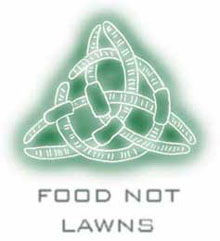Guild it, and they will come
Mother Nature does not plant straight rows, and she most definitely does not plant whole acres of just one type of plant, spaced exactly eight inches apart, with absolutely no other plants allowed to grow anywhere nearby...
A plant guild may be defined as any group of plants which support each other while growing near each other. "Guilding" is the act of intentionally placing plants to grow near each other so that they may help to provide for each other's needs, thereby creating a more healthy and diverse farm ecosystem and also making less work for the farmer....(that's right folks, I said LESS WORK for the farmer, meaning LESS weeding, fertilizing, LESS pest managementalizing, etc.... however, do allow for a little more harvest time, due to the bit of extra time it may take to separate crops during harvest... a well planned guild will yield all year 'round, providing food, seed and compost crops for farmers, wildlife and microorganisms alike.
A classic sample guild would be the traditional "Three sisters" corn-beans-squash combo. Native tribes in North and South America have long been practicing the ancient art of companion/guild planting. In this example, corn is the staple crop, a heavy feeder which needs extra fertile soil. Beans provide the bonus nitrogen, as they climb up the sturdy corn stalks. Squash provides a shady ground cover, and with its spiny branches, helps to deter would-be marauders from ravaging the corn patch. A fourth sister was also employed, Spider Flower (Cleome spp.). Cleome is quite aromatic with a magnificent flower; these traits attract beneficial pollinators, and the spiny stems further protect neighboring crops. Cleome is an excellent companion for many crops, grows quite well in the Willamette Valley, and yields a magnificently beautiful flower.
Bill Mollison's Permaculture Design manual has an excellent section on guilding, and there are several good books that focus specifically on companion planting, which is a similar concept (see book list below). What sets guilds apart from companion- of inter-planting methods is that they often incorporate perennial plants rather than annuals, with several goals in mind, including (but never limited!) decreased erosion, self-managing crops and long term ecological sustainability. From a Permaculture perspective, the art of guilding is an essential skill for establishing the lush low-maintenance perennial food-providing gardens we all love to live in!
Here's a profile of an Apple or Pear guild that does well in the Northwest:
Apple or Pear (Malus spp. or Pyrus spp.)... Nutritious and delicious! 65 + species to choose from, size, color and flavor that may surprise you! The world's biggest pear collection is actually growing in Corvallis, and every Spring there's a bioregional scion swap in Tigard. Most Apples and Pears do need some pruning, but if done well, the maintenance can be kept to a minimum.
Comfrey (Symphytum spp.)shades roots of the tree and competes with grasses. Some invasive grasses have root excretions which inhibit the growth of apple and pear trees, so it is especially important to keep these out of the root zone. Comfrey also provides mulch material and can be made into a nutritious compost tea.
Horseradish (Armoracia rusticana) also spreads by the roots, but near the surface, and competes well with above-mentioned grasses. It has also been known to be effective against Monilia in apple trees. To make the popular condiment, just grate the bulbous roots and add vinegar.
Chives (Allium schoenoprasum) are an excellent companion for just about anything; they are extremely pest resistant, and are anti fungal and insecticidal. Flowers attract wasps and other predatory beneficials. Raw chive tea is effective against apple scab, aphids, and mildew on gooseberries and cucurbits. Plus they're yummy and loaded with vitamins! When left to re-seed, they will provide a grassy-looking groundcover, along with..
Clover (Trifolium spp.) grown as a ground cover amidst the plants listed above will help to fix nitrogen and compete with other less desirable weeds. My favorite is Dutch clover (Trifolium repens), which is a self-seeding annual with edible flowers and the occasional four-leaf luck charm.
Sweet Peas (Lathyrus spp.) planted against the sunny side of the trunk of your tree will climb into the branches and provide summer-long blooms, as well as fixing nitrogen in the soil below. Annual varieties are less likely to crowd the tree limbs, and will come back every year. However, some of the perennial species have edible tubers, which is a nice bonus. Another option would be to grow pole beans for a summer crop.
Tulips bloom early in the Spring, before other perennials have emerged, and just in time to attract pollinators to those little apple blossoms. They also provide some often-needed farmer morale on those chilly March mornings.
Top dressing your guilds with some compost once or twice a year will help with fertility, and sprinkling on a little Biodynamic preparation every now and then doesn't hurt either. Otherwise it's a low-low maintenance operation, with overwhelming abundance being the big problem to face!
It is important to mention that , while there are many hundreds of plant combinations that will do well in similar climates, it is important to look for guilds that do particularly well in your particular microclimate.
There are other aspects to guilding as well; these include incorporating insect, reptile, bird and animal participants, and considering all factors when working within natural cycles. After all, Nature will always prevail; planting guilds is merely another way in which to influence Her with creative recipes to suit individual and community needs.
Books to check out on guilding, companion planting and polycultural gardening:
Permaculture Designers Manual, B. Mollison
Gardening for the Future of the Earth, H. Shapiro
Culture and Horticulture, W. Storl
Gaia's Garden, T. Hemenway
Companion Planting, H. Philbrick
Designing and Maintaining your Edible Landscape, R. Kourik
